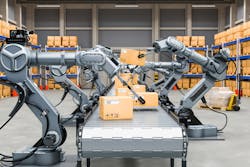Making the switch from a manually run warehouse to an automated warehouse is a significant change, and its impact should be taken seriously. Even the slightest introduction of automated technology can have a significant effect on warehouse processes, the inventory management systems, and the workers who would need to adapt to the introduction of new technology. Introducing automated technology, whether it’s the enhancement of current warehouse technology, or a fully integrated solution can give a company a huge competitive advantage. Benefits could include more streamlined processes, lower costs, better customer satisfaction, and improved employee productivity.
Automated warehousing, however, is a solution that needs to be consistently monitored and maintained. Otherwise, there are risks that could come with it. These include not maximizing the capacity of the technology, increased operational complexity, and reduced flexibility. Learning how to properly implement and use automated warehouse technology will allow a company to experience the full benefits of their investment. Here are some tips to ensure that this happens.
Optimize the layout and design of the warehouse
Automated warehouse technology can have limitations and sometimes may not be able to respond adequately to unexpected changes, peaks, and declines in demand. The limitations of these solutions could be dealt with in the design phase prior to setting up the warehouse or integrating the technology. Given that a company’s investment in automating a warehouse could be on a significantly large scale, the planning should be very long term and ideally, should include robust forecasts of changes (ex. Industrial changes, company growth, etc.).
This should be done even for investments in automation that are on a smaller scale as poor planning could catch up in the event of future expansions or changes to the warehouse. Designs should have a clear path in anticipation of future warehouse equipment upgrades and changes, with a focus on areas that are the most likely to experience changes. This includes a stock-keeping unit (SKU) growth, output increase, and stock reduction. It is essential for the warehouse manager to scrutinize assumptions about current processes and test how sensitive these processes are to variations in output, customer demands, and business metrics.
Also, ensure that cross-docking is applied to maximize space. The main goal of cross-docking is to decrease the amount of shelf storage time of stocks in the warehouse. This is useful because it helps in moving delivered warehouse goods as quickly as possible to outbound carriers that can move the items to distribution centers. Ensure that the warehouse layout supports cross-docking even with the implementation of automated warehouse technology.
Ensure the right automated solutions are being utilized
Investing in automated technology can sometimes be a huge investment for a lot of companies, both large and small. Due to this, companies should spend a lot more time ensuring that they are investing in the right solutions that address their most pressing business needs. Failing to pick the right solution could be problematic in a lot of ways. If the technology doesn’t meet the optimum specification required to carry out a warehouse’s automation needs, then operating costs throughout the lifespan of the equipment could be increased.
Therefore, selecting the appropriate solution and automation partner to deliver these solutions successfully is crucial. One way to ensure that this is achieved with minimal risk is to use a professional and robust tender management process. This process should be structured and objective, ensuring that technology vendors have the right information needed to design solutions that allow them to bid appropriately. Using an independent and experienced third party to manage this process would be ideal and allow for performance levels to be evaluated more critically. Sometimes, written communications and processes could get interpreted in different ways between the client and the vendor. Therefore, both parties need to ensure a clear understanding of these processes before any solutions are implemented.
Implementation and maintenance needs to be comprehensive and continuous
Sometimes delays in implementing new solutions or maintaining existing solutions could occur. As a result, there is a temptation to simplify the testing process and other important safety and reliability measures. As a client, you should always ensure testing must be robust and comprehensive regardless of business pressures or pressure from the vendors. Otherwise, poor implementation could follow. One advantage of ensuring robust testing is that it identifies potential operational issues and equipment constraints. These problems become visible to the warehouse staff, which allows them to be prepared if something goes wrong.
Staff should be involved in the implementation and maintenance processes early on. This way, they are adequately trained and have the right skillsets when the automated process is finally implemented or needs maintenance. Staff should be educated on why these automated processes have been implemented and how it can make them more productive and efficient. This keeps staff engaged and would even allow them to make significant contributions towards improving your automated warehouse.
Implement strict safety standards
Working in a warehouse does come with hazards. There are statistics that show workplace accidents and deaths still occur regularly. This is still possible, even with an automated warehouse. It doesn’t have to be this way, however. There is no reason for warehouses to be unsafe for employees. When staff isn’t trained adequately on how to use the technology and machinery available in the warehouse, accidents and OSHA citations and penalties could occur. Ensure that employees are well trained and always aware of any new technology introductions to the warehouse. This allows them to understand the implications of these new technologies on their current processes. Also, confirm that standard workplace safety protocol is being observed at all times.
About the Author

David Madden
David Madden is an efficiency expert, as well as being the Founder and President of Container Exchanger. His passion and business is to save companies money through the use of used reusable and repurposed industrial packagings such as plastic and metal bulk containers, gaylord boxes, bulk bags, pallets, IBC totes, and industrial racks. He holds an MBA as well as a certificate from Daimler Chrysler Quality Institute for completion of six-sigma black belt training.
